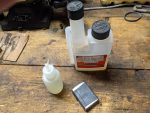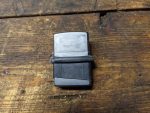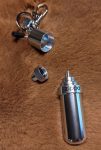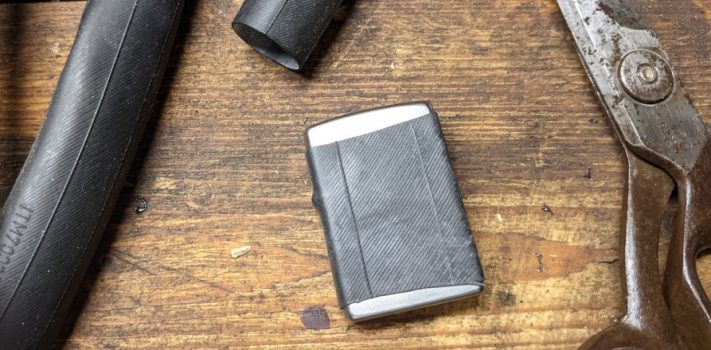The iconic Zippo lighter is an excellent tool for starting fires. Battlefield tested from World War 2 to the War on Terror, it has proven to be a versatile, durable, and reliable tool in daily use.
One major drawback of the Zippo is that it loses fuel fairly quickly due to evaporation. I had previously read about an old trick for slowing this evaporation by using a piece of bicycle inner tube. I decided to give it a try.
Lighter History
A lighter is a portable and reusable device designed to produce a flame.
Already in the 1600s, the first lighter-type devices were developed. These devices were tinderboxes that used a wheel lock mechanism similar to those employed by the firearms of the time. Sparks from the lock were used to ignite gunpowder or other flammable substances in order to create a flame. When firearms advanced from the wheel lock to the flintlock, these early lighters followed in their footsteps.
Then in the 1800s, chemist Johann Wolfgang Döbereiner invented a device that created a flame by passing hydrogen over a platinum catalyst. The device proved quite popular, although it was unwieldy and somewhat dangerous to use.
The next major step forward in lighter technology was built upon the development of ferrocerium by Carl Auer von Welsbach in 1903. For the next six decades and longer, sparks produced by ferrocerium became the most widely used ignition source for lighters.
During World War I, trench warfare was characterized by some as long periods of boredom punctuated by short interludes of pure terror. Many soldiers coped with the periods of boredom by crafting lighters from readily salvageable battlefield materials like spent cartridge cases of various sizes. Their frequent exposure to the elements inspired these soldiers to introduce design improvements like perforated chimneys intended to help protect the lighter’s flame from the wind. These improvements were adopted into the lighter designs of the interwar period.
In the early 1930s, George G. Blaisdell observed a friend using an Austrian-made lighter. Blaisdell felt that he could improve on the concept, and in 1932 he introduced his new “Zippo” lighter.
With American entry into World War 2, the Zippo company dedicated their entire production output to meeting the needs of the US military. Supplying millions of American military personnel around the world with lighters established Zippo as a distinctively American product.
Starting in the 1950s, butane lighters began to overtake liquid fuel lighters in popularity. More recently, electric plasma lighters have become more widely available. One drawback of butane and plasma lighters is that they do not work well under cold weather conditions. Butane does not vaporize at standard pressure at temperatures lower than 31.2 degrees Fahrenheit. As a result, butane lighters do not work reliably at below-freezing temperatures. In the same way, the batteries of electric plasma lighters become less effective in the cold. This gives liquid fuel lighters like the classic Zippo, which can operate more reliably at cooler temperatures, continuing relevance.
Another bonus for Zippo lighters is that they are still made in the USA.
Fuel
Liquid fuel lighters like the classic Zippo can utilize a variety of fuels such as kerosene, gasoline, diesel fuel, fuel oil and alcohol. The fuels that seem to function the most reliably, especially under cold weather conditions, are mixtures composed mostly of naphtha. The desire for a naphtha-based fuel left me with several options when I recently purchased more fuel for my Zippo.
The most obvious option was Zippo brand fuel. A 12 ounce can typically costs about six dollars. This gives a unit cost of about 50 cents an ounce.
Another option was VM&P Naphtha. At about $13 a gallon, the unit cost comes out to about 10 cents an ounce.
A third option was Coleman Camp Fuel. At about $12 a gallon, the unit cost comes out to about 9 cents an ounce.
Since the Coleman Camp Fuel presented the lowest cost per ounce, that is what I purchased.
A standard Zippo lighter holds about a half-ounce of fuel when full. This makes a gallon of camp fuel sufficient to refill my Zippo about 266 times. That should keep all of my lighters well fueled for many years to come.
Filling the Zippo
 It is obviously impractical to fill a Zippo directly from a gallon can of Coleman Camp Fuel. Instead, I used a funnel to pour from the gallon camp-fuel-can into an empty, one-quart-sized container in which I had originally purchased Stabil Storage Fuel Stabilizer. I had re-labeled the one-quart container to clearly identify its new contents. I then used the dispenser spout of the fuel stabilizer container to fill a two-ounce Nalgene drop bottle. I used the drop bottle to fill the Zippo, and then returned the extra fuel from the drop bottle to the fuel stabilizer container. I had previously learned that fuel would eventually evaporate from the drop bottle if it was not emptied.
It is obviously impractical to fill a Zippo directly from a gallon can of Coleman Camp Fuel. Instead, I used a funnel to pour from the gallon camp-fuel-can into an empty, one-quart-sized container in which I had originally purchased Stabil Storage Fuel Stabilizer. I had re-labeled the one-quart container to clearly identify its new contents. I then used the dispenser spout of the fuel stabilizer container to fill a two-ounce Nalgene drop bottle. I used the drop bottle to fill the Zippo, and then returned the extra fuel from the drop bottle to the fuel stabilizer container. I had previously learned that fuel would eventually evaporate from the drop bottle if it was not emptied.
The Old Trick
Now I was ready to test the old trick to prevent evaporation from the Zippo lighter. A local bicycle shop had given me a couple of old inner tubes. I cut a length of inner tube just slightly shorter than the Zippo, and pulled it over the lighter like a sleeve.
Bicycle Inner Tubes
 Old bicycle inner tubes are useful for a host of different tasks. Rubber bands of various widths can be cut directly from the tubes. For longer and heavier bands, a length of tube can be cut and tied to the appropriate size. A strip of inner tube rubber wrapped around the outside of a smaller hose can enable that hose to fit snugly inside a larger hose, creating a relatively secure seal for irrigation purposes.
Old bicycle inner tubes are useful for a host of different tasks. Rubber bands of various widths can be cut directly from the tubes. For longer and heavier bands, a length of tube can be cut and tied to the appropriate size. A strip of inner tube rubber wrapped around the outside of a smaller hose can enable that hose to fit snugly inside a larger hose, creating a relatively secure seal for irrigation purposes.
The Test
I placed the bicycle tube sleeve over the Zippo, and left it on the work bench in my barn. Then (with one exception) each day for the next 57 consecutive days I went to the barn, rolled the inner-tube sleeve down below the lid, opened the lid, and flicked the flint wheel of the Zippo. Every day, the Zippo responded with a flame. The one exception was on Day 22, when I was out of town. I ignited the Zippo twice on Day 24 to compensate for it not being ignited on Day 22.
On Day 27 I had a trace of oil in my right hand. I noticed that this trace of oil made it quite difficult for me to roll down the bicycle tube sleeve. This potential difficulty in accessing the lighter is one factor to keep in mind if one chooses to use a bicycle tube sleeve.
Over the course of time, the flame produced by flicking the flint wheel gradually diminished in size, but the Zippo continued to light as reliably as clockwork. Then on Day 58, flicking the flint wheel would no longer produce a flame. The fuel was finally exhausted.
I next tested the Zippo without the use of the bicycle inner tube sleeve. I refilled the Zippo, and flicked the flint wheel on 11 consecutive days. Getting the lighter to ignite required more than one attempt on many of these days. Evidently, the bicycle tube sleeve not only slows evaporation, but it also helps the wick remain more damp with fuel in-between lighting attempts. The dryer wick without using the sleeve was more difficult to light.
Then on Day 12, the Zippo would not light. The fuel was once again exhausted.
So, using the bicycle inner tube sleeve slowed fuel evaporation from the Zippo enough to extend its operation from 11 days to 57 days.
Fuel for the Field
If you are planning on being in the field for a while, you may want extra fuel along for your Zippo lighter. A small can of Zippo fuel is reasonably sturdy. But perhaps you are using an alternate fuel, like Coleman Camp Fuel. Zippo cans are not refillable. Or perhaps you want a larger or smaller supply than what comes in a Zippo can.
 An alternative for a smaller supply of fuel is a Zippo Fuel Canister. This sturdy, aluminum container holds about ½ ounce of fuel, which is enough to fill a lighter once. The canister also has a sleeve that can hold a couple of extra flints as well. One other alternative for a larger supply of fuel is a hip flask. I have often seen hip flasks for sale in second-hand stores at reasonable prices. If you use a hip flask, you will want to clearly and prominently label it. It would be bad for someone to take a nip and end up with a mouthful of toxic fuel.
An alternative for a smaller supply of fuel is a Zippo Fuel Canister. This sturdy, aluminum container holds about ½ ounce of fuel, which is enough to fill a lighter once. The canister also has a sleeve that can hold a couple of extra flints as well. One other alternative for a larger supply of fuel is a hip flask. I have often seen hip flasks for sale in second-hand stores at reasonable prices. If you use a hip flask, you will want to clearly and prominently label it. It would be bad for someone to take a nip and end up with a mouthful of toxic fuel.
Conclusions
Placing a sleeve cut from a bicycle inner tube over a Zippo lighter can significantly slow fuel evaporation. I had expected it to slow evaporation by a week or two, perhaps a month at the most. I was very surprised and pleased to discover that it would slow evaporation by 46 days. This greatly extends the usefulness of a Zippo lighter in the field.
Disclaimer
I did not receive any financial or other inducements to mention any vendor, product, or service in this article.










